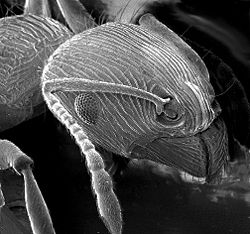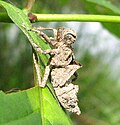Exoskeleton

An exoskeleton supports and protects an animal's body from outside and not like the internal endoskeleton - of, for example human beings - from inside.
Many invertebrate animals (such as shelled mollusks) have exoskeletons in the sense of external hard parts. But if one speaks of an exoskeleton one mostly means that of arthropods (i.e. insects, spiders, myriapods and crustaceans).
Exoskeletons contain rigid and resistant components that fulfil a set of functional roles including protection, excretion, sensing, support, feeding and (for terrestrial organisms) acting as a barrier against desiccation. Exoskeletons first appeared in the fossil record about 550 million years ago, and their evolution has been seen as critical as a driving role in the Cambrian explosion of animals that took place after this time.
The exoskeleton ( exoskeleton suit[dead link]) is a device intended to restore the lost motion functions of a person or other living being. The exoskeleton also serves to increase human muscle strength and range of motion by means of an external skeleton and drive elements.
Exoskeleton Media
Exoskeleton of cicada attached to a Tridax procumbens (colloquially known as the tridax daisy)
cicada exoskeleton
Other websites
Biology
Modern technology
- Bionic Boots Archived 2008-12-18 at the Wayback Machine
- PowerSkip Archived 2010-10-05 at the Wayback Machine
- Berkeley Lower Extremity Exoskeleton (BLEEX) Archived 2010-09-24 at the Wayback Machine
- University of Washington Exo Arm Project Archived 2008-12-26 at the Wayback Machine


